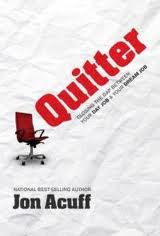 A few weeks ago, Shae and I went to Jon Acuff’s Quitter Conference. There was so much amazing content there – we’d highly recommend it for anyone, no matter what career you have or what stage of life you’re in.
A few weeks ago, Shae and I went to Jon Acuff’s Quitter Conference. There was so much amazing content there – we’d highly recommend it for anyone, no matter what career you have or what stage of life you’re in.
Here are three points that stuck out to me though that I think are worth us youth workers bearing in mind:
1. Don’t compare your beginning to someone else’s middle
We mentioned this quote in yesterday’s post, but it’s well worth mentioning again. In youth work, it’s so easy to look at others – other organizations’ programs, other youth workers, other youth centers – and be jealous. To wish that we had everything they did and all the success that they have. What we often overlook though is that most of the time, it’s taken a long time to get there.
That organization with amazing programs? They’ve been working on and refining those programs for a decade, whereas you’ve only started your new program recently.
That youth pastor speaking at a conference? He’s been doing this for 25 years, whereas you’ve only been a full time youth worker for a couple of years.
That youth center with all the equipment? They’ve been fundraising and grantwriting for many years and have worked really hard on making local connections.
So don’t beat yourself up that you’re not achieving everything that others are – you might just be beginning in comparison.
2. Be brutally realistic about your present & wildly unrealistic about your future
Look at the youth work you’re doing at the moment. Be realistic about what you’re currently achieving. Where you’re actually spending your time. What you’re really spending your budget on. Which young people you’re truly reaching.
Then consider your vision for your future, being as unrealistic and optimistic as possible. What do you want to achieve? What would you prefer to spend your time on? What areas would you want to divert your budget to? What other young people do you want to reach?
Dream.
3. Execute
Finally, another of the points that Jon made was that:
- Lots of people can imagine an idea
- Less can capture an idea
- Very few people can execute an idea
And fewer people even attempt to execute an idea. Don’t let fear paralyze you. Dream unrealistically.
If you think setting up a homework club is going to be beneficial for the young people in your community, don’t listen to the voices telling you that it’s too hard or that it won’t be a success or that you won’t have enough volunteers. Do it.
If you’re not reaching enough young people and want to start doing some schools work, don’t spend all your time worrying that schools will say no. Contact them.
If you’re worried that you’re too young / too old / too uncool / don’t know enough about technology / don’t know enough about youth culture / don’t have the qualifications – stop worrying. Just execute.
If you try something and it doesn’t work out, what’s the worst thing that’ll happen? You’ll have spent a year trying to improve the lives of young people. What’s the best thing that’ll happen? You’ll change the course of young people’s lives. Helped them achieve all that they were capable of, but just needed an adult to believe in them.
Question: What dreams do you have for your youth work? We’d love to hear them in the comments below.
You can also connect with us by:
- Signing up to receive our posts via email
- Following us on Twitter
- Liking us on Facebook
- Signing up to our RSS feed



 Last week we shared the first 7 items to include when
Last week we shared the first 7 items to include when